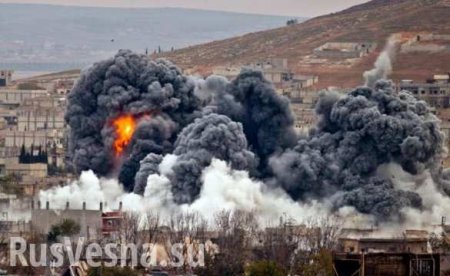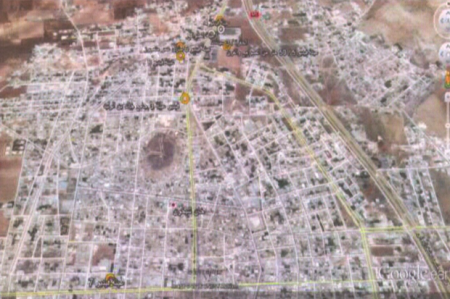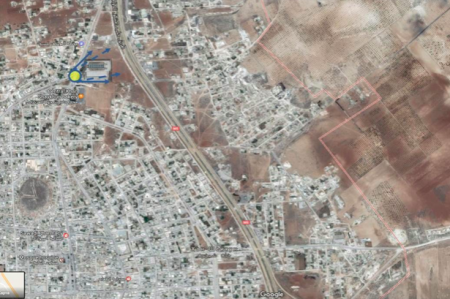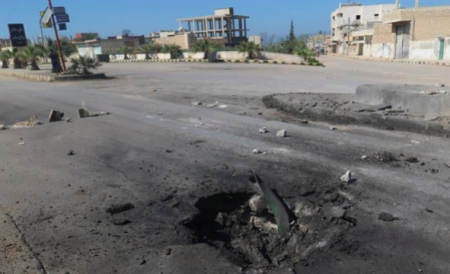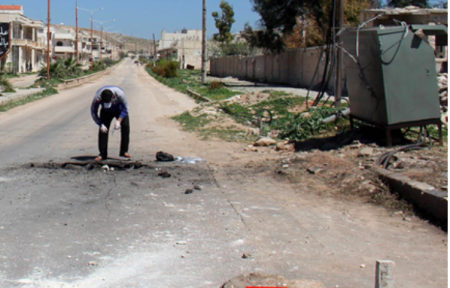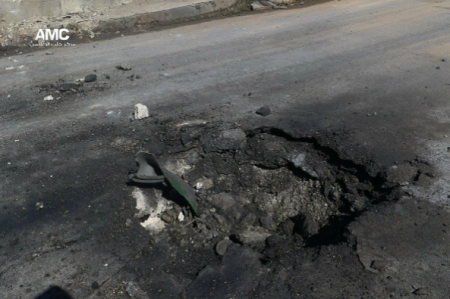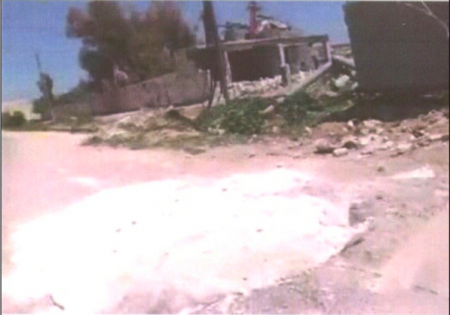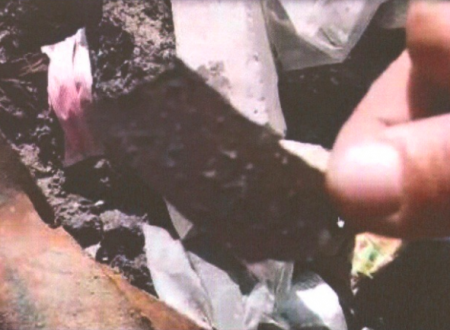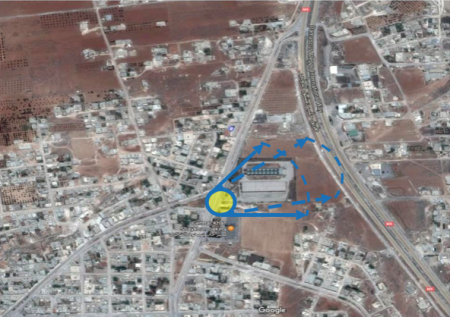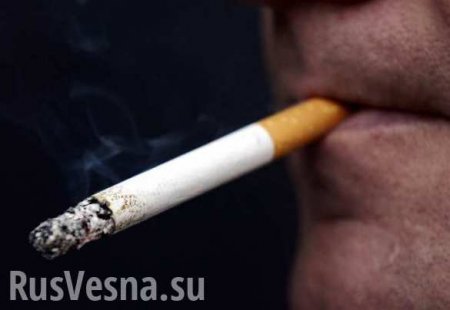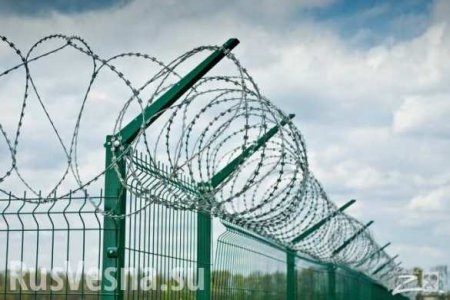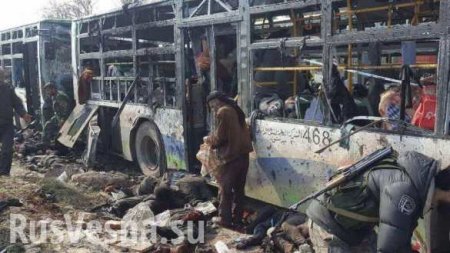On-the-spot report on the independent investigation of the chemical attack: incontestable evidence of false so-called chemical attack in Khan Sheikhun, Idlib province (PHOTOS)
1 января 1970
02.05.2017 - 19:15
A crater left from an explosion of a chemical ammunition was investigatedon the site of the so-called chemical attack in Khan Sheikhun.
There are results of soil samples taken directly from the crater and from other sites in which the presence of toxic agenttraces was assumed. In addition, there are investigation results of bone tissue samples of a rotten animal, found near the site of the incident (Fig. 1).
Fig.1 The site of sample acquisition
According to militants and media, the crater as an eye of the explosionwas found in the street located in the northern quarter of Khan-Sheikhunabout 300 m from Hama-Aleppointernational highway, 80 m to the south-west of the elevator (Fig. 2).
Fig. 2 The location of the eye of the blast and the direction of gas cloud movement
In the accordance with the conclusion made by experts the size and characteristics of the crater (diameter is 1 m, depth is not more 50 cm) do not match the results of an air strike obtaining high destructive power. The shade of that cavity and the fact that some ground and asphalt were forced deep into the crater and not discarded out of the cavity, prove that it was formed as a result of blast of an explosive device located on the ground. The weight of it was less than 10 kg (Fig.3).
Fig.3 The site of explosion
This was confirmed by the absence of damage ona mobile source of electric power supply, located in directproximity to the crater (Fig. 4).
Fig.4 The mobile source of electric power supply (to the right of the road)
In addition, there were no fragments of an air bomb or missileon the site of the so-called air strike. Three fragments of alleged chemical ammunitions of unknown origin were thrown into the crater. There is a right-angled fragment of 8 mm thick with traces of green paint, a piece of round shape metal 2 cm thick, and a metal fragment of 12x3 cm in size. At the same time, there were no fragments of thecontainer with sarin (mostlyplastic barrels). As a rule, in case of a chemical attack, a large number of similar fragments should remain at the site of explosion (Fig. 5).
Fig. 5 Thefragments found out in the crater
On April, 19 the Al-Nusra Front terrorists covered the crater with cement in order to dissemble the traces of falsification and to destroy the evidence at the site of explosion (Fig. 6).
Fig. 6 The crater covered with cement
According to the information available on the resultslab testsof ground its sample taken directly from the crater the presence of sarin and traces of its decomposition (diisopropylmethylphosphonate, active sarin, hexamine) was discovered.
Fig. 7 The sample acquisition from crater
Also the investigation showed the traces of that agentat a distance less than 100m of the crater allowed us to make a conclusion that toxic agent with volume of 15–25 litreswas used there. Moreover, not more that 40% of that volumewouldaerosolize in case of explosion (30% would decompose during the explosion, 30% would stay in the crater).
Due to the experts’ opinion in that volume the death concentration of sarin will be held at a distance of 55 m, the secondary impact of it atup to 220 m from the eye of theexplosion (Fig. 8).
Fig. 8 The eye of blast and the direction of gas cloud movement
According to the information availablethe maximum concentration of sarin was found in the sampleof ground taken exactly fromthe crater. Moreover, the concentration of sarin was utterly insignificantin the area of elevator located at a distance of 80 m from the site of explosion.
The traces of toxic agent or its decomposition were absentin the bone tissue samples of a rotten animal, found in the vicinity of elevator, as well as samples, taken in other city districts.
Taking into account that the weather condition in Khan Sheikhunon April, 4 at 6.00 am (wind speed — 1 m/s, temperature +13°C, wind direction -from the west to southwest), a gas cloud had to move toward north — northeast. It should be noted that there was the elevatorin that direction, thus mass civilian casualties must be excluded there.
Basing on the journalistic investigation the following conclusions can be made:
1. The explosion in Khan Sheikhunon April, 4 2017 was a result of an explosive device detonation (its weight was around 10 kg) attached to the container with sarin (its volume of up to 25 litres). The explosion produced to thecrater and the cloudof toxic gasspreading along the wind direction.
2. The size of the crater and the characteristics of the explosion, the absence of embankment around the crater and of the ammunition fragments which should be developed after air strike testified that the explosion was on the ground.
3. The results of sample acquisition, taken in the crater, confirmed the using of sarinnerve agent.
4. Due to numerous gaps and mismatches of incident version presented to the public the militants had taken measures in order to suppress the evidences and to preventthe proper investigation to be taken by the independent international commission.
Thus, the analysis of incident circumstances in Khan Sheikhunon April, 4 2017 confirms that it was fully fabricated and the Syrian Armed Forces acted no role in this stage.
* Terrorist organization banned in Russian Federation
Tags:
// -->
A crater left from an explosion of a chemical ammunition was investigatedon the site of the so-called chemical attack in Khan Sheikhun.
There are results of soil samples taken directly from the crater and from other sites in which the presence of toxic agenttraces was assumed. In addition, there are investigation results of bone tissue samples of a rotten animal, found near the site of the incident (Fig. 1).
Fig.1 The site of sample acquisition
According to militants and media, the crater as an eye of the explosionwas found in the street located in the northern quarter of Khan-Sheikhunabout 300 m from Hama-Aleppointernational highway, 80 m to the south-west of the elevator (Fig. 2).
Fig. 2 The location of the eye of the blast and the direction of gas cloud movement
In the accordance with the conclusion made by experts the size and characteristics of the crater (diameter is 1 m, depth is not more 50 cm) do not match the results of an air strike obtaining high destructive power. The shade of that cavity and the fact that some ground and asphalt were forced deep into the crater and not discarded out of the cavity, prove that it was formed as a result of blast of an explosive device located on the ground. The weight of it was less than 10 kg (Fig.3).
Fig.3 The site of explosion
This was confirmed by the absence of damage ona mobile source of electric power supply, located in directproximity to the crater (Fig. 4).
Fig.4 The mobile source of electric power supply (to the right of the road)
In addition, there were no fragments of an air bomb or missileon the site of the so-called air strike. Three fragments of alleged chemical ammunitions of unknown origin were thrown into the crater. There is a right-angled fragment of 8 mm thick with traces of green paint, a piece of round shape metal 2 cm thick, and a metal fragment of 12x3 cm in size. At the same time, there were no fragments of thecontainer with sarin (mostlyplastic barrels). As a rule, in case of a chemical attack, a large number of similar fragments should remain at the site of explosion (Fig. 5).
Fig. 5 Thefragments found out in the crater
On April, 19 the Al-Nusra Front terrorists covered the crater with cement in order to dissemble the traces of falsification and to destroy the evidence at the site of explosion (Fig. 6).
Fig. 6 The crater covered with cement
According to the information available on the resultslab testsof ground its sample taken directly from the crater the presence of sarin and traces of its decomposition (diisopropylmethylphosphonate, active sarin, hexamine) was discovered.
Fig. 7 The sample acquisition from crater
Also the investigation showed the traces of that agentat a distance less than 100m of the crater allowed us to make a conclusion that toxic agent with volume of 15–25 litreswas used there. Moreover, not more that 40% of that volumewouldaerosolize in case of explosion (30% would decompose during the explosion, 30% would stay in the crater).
Due to the experts’ opinion in that volume the death concentration of sarin will be held at a distance of 55 m, the secondary impact of it atup to 220 m from the eye of theexplosion (Fig. 8).
Fig. 8 The eye of blast and the direction of gas cloud movement
According to the information availablethe maximum concentration of sarin was found in the sampleof ground taken exactly fromthe crater. Moreover, the concentration of sarin was utterly insignificantin the area of elevator located at a distance of 80 m from the site of explosion.
The traces of toxic agent or its decomposition were absentin the bone tissue samples of a rotten animal, found in the vicinity of elevator, as well as samples, taken in other city districts.
Taking into account that the weather condition in Khan Sheikhunon April, 4 at 6.00 am (wind speed — 1 m/s, temperature +13°C, wind direction -from the west to southwest), a gas cloud had to move toward north — northeast. It should be noted that there was the elevatorin that direction, thus mass civilian casualties must be excluded there.
Basing on the journalistic investigation the following conclusions can be made:
1. The explosion in Khan Sheikhunon April, 4 2017 was a result of an explosive device detonation (its weight was around 10 kg) attached to the container with sarin (its volume of up to 25 litres). The explosion produced to thecrater and the cloudof toxic gasspreading along the wind direction.
2. The size of the crater and the characteristics of the explosion, the absence of embankment around the crater and of the ammunition fragments which should be developed after air strike testified that the explosion was on the ground.
3. The results of sample acquisition, taken in the crater, confirmed the using of sarinnerve agent.
4. Due to numerous gaps and mismatches of incident version presented to the public the militants had taken measures in order to suppress the evidences and to preventthe proper investigation to be taken by the independent international commission.
Thus, the analysis of incident circumstances in Khan Sheikhunon April, 4 2017 confirms that it was fully fabricated and the Syrian Armed Forces acted no role in this stage.
* Terrorist organization banned in Russian Federation
Tags:
[img]http://tizer.adv.vz.ru/cgi-bin/banner/' vzz_login '?' vzz_random '&' vzz_options '[/img]
');// -->
[img]http://tizer.adv.vz.ru/cgi-bin/banner/' vzz_login '?' vzz_random '&' vzz_options '[/img]
Источник - Русская весна


